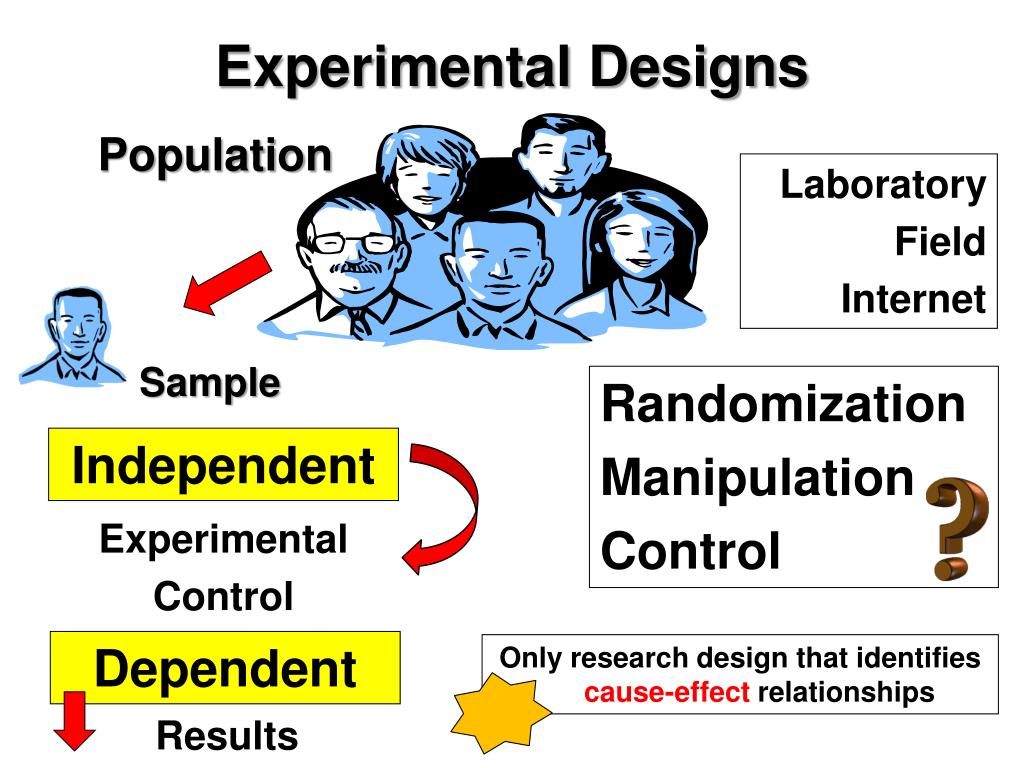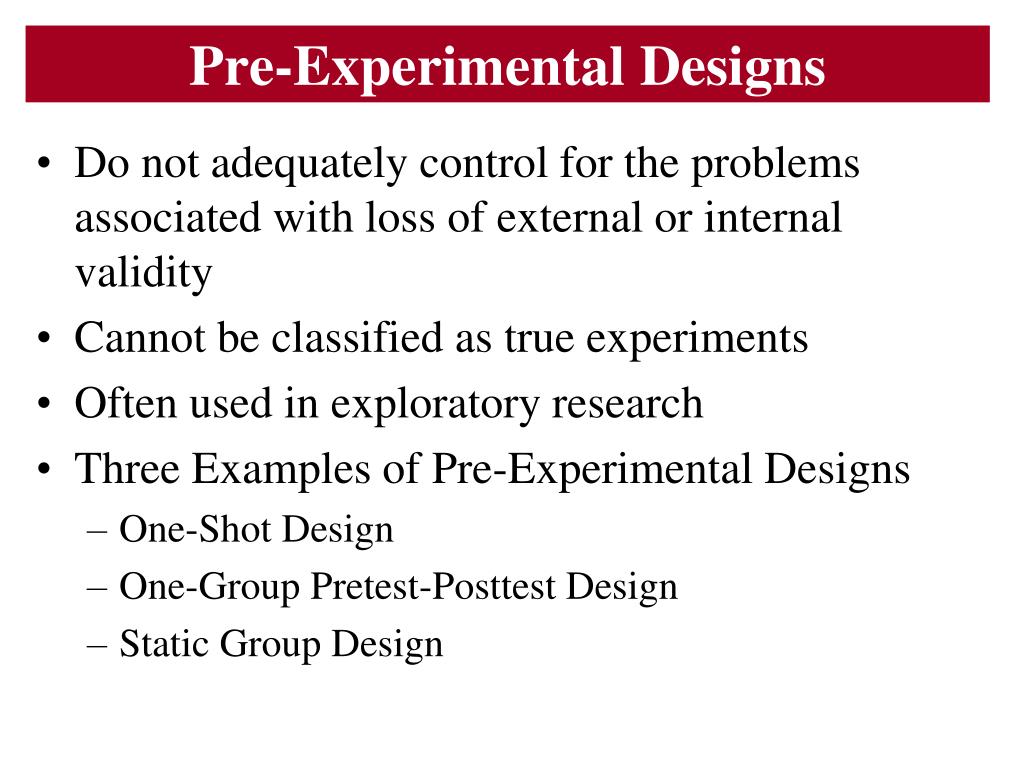Table Of Content

If you can't find the information in the article's publication information, the next step is to read the article's Abstract and Methodologies. In at least one of these sections, the researchers will state whether or not they used a control group in their study and whether or not the control and the intervention groups were assigned randomly. Random Assignment means subjects are randomly assigned to whether they will be in a control group or a group that receives an intervention. The study of the design of experiments is an important topic in metascience. A company in the product development phase creates multiple prototypes for testing. With a randomized selection, researchers introduce each test group to a different prototype.
Quantitative data analysis
This involves randomly assigning participants to different groups or treatments to ensure that any observed differences between groups are due to the treatment and not to other factors. This design involves dividing participants into blocks based on a specific characteristic, such as age or gender, and then randomly assigning participants within each block to one of two or more treatment groups. You manipulate one or more independent variables and measure their effect on one or more dependent variables. All variables which are not independent variables but could affect the results (DV) of the experiment.
Step 2: Choose a type of research design
Now, let's talk about a player who's a bit of an outsider on this team of experimental designs—the Non-Experimental Design. Think of this design as the commentator or the journalist who covers the game but doesn't actually play. In a correlational study, researchers don't change or control anything; they simply observe and measure how two variables relate to each other. In real life, it's often not possible or ethical to randomly assign people to different groups, especially when dealing with sensitive topics like education or social issues. It wants to be just like its famous relative, but it's a bit more laid-back and flexible.
Evaluation of Experimental Design Psychology
It's like the game plan in sports or the blueprint when you're building a house. Just like you wouldn't start building without a good blueprint, researchers won't start their studies without a strong experimental design. A good research student can look at a design’s methodology and correctly categorize it. Below are some typical examples of experimental designs, with their type indicated. The advantage of this design is that it has high external validity, as it involves testing participants in real-life settings. But it can introduce individual differences that could confound our results.
Latest articles
Not all kinds of experimental research can be carried out using simulation as a data collection tool. It is very impractical for a lot of laboratory-based research that involves chemical processes. It measures and observes the variables of interest without changing existing conditions. Many experiments are carried out in the laboratory, where control can be exerted on the extraneous variables, thereby eliminating them.
Questionnaire – Definition, Types, and Examples
Non-Experimental Design has always been a part of research, especially in fields like anthropology, sociology, and some areas of psychology. In a Non-Experimental Design, researchers are like reporters gathering facts, but they don't interfere or change anything. This design is great at proving that two (or more) things can be related. Correlational designs can help prove that more detailed research is needed on a topic.
Experimental Designs
The true experimental research design relies on statistical analysis to approve or disprove a hypothesis. It is the most accurate type of experimental design and may be carried out with or without a pretest on at least 2 randomly assigned dependent subjects. If a within-subjects design would be difficult or impossible to carry out, then you should consider a between-subjects design instead. Or imagine you were trying to reduce people’s level of prejudice by having them interact with someone of another race. A within-subjects design with counterbalancing would require testing some participants in the treatment condition first and then in a control condition. But if the treatment works and reduces people’s level of prejudice, then they would no longer be suitable for testing in the control condition.

Fertilizer and Plant Growth Study
For example, you can't really have half a school following a new reading program while the other half sticks with the old one; that would be way too confusing! Cluster Randomization helps get around this problem by treating each "cluster" as its own mini-experiment. A well-known example of Crossover Design is in studies that look at the effects of different types of diets—like low-carb vs. low-fat diets. Researchers might have participants follow a low-carb diet for a few weeks, then switch them to a low-fat diet. By doing this, they can more accurately measure how each diet affects the same group of people.

A pre-experimental research study is a basic observational study that monitors independent variables’ effects. One is that each participant has an equal chance of being assigned to each condition (e.g., a 50% chance of being assigned to each of two conditions). The second is that each participant is assigned to a condition independently of other participants. Thus one way to assign participants to two conditions would be to flip a coin for each one. When the procedure is computerized, the computer program often handles the random assignment. The former are called between-subjects experiments and the latter are called within-subjects experiments.
The takeaways from 35 co-living projects were distilled into these experimental designs - Fast Company
The takeaways from 35 co-living projects were distilled into these experimental designs.
Posted: Tue, 22 Mar 2022 07:00:00 GMT [source]
Within-subjects experiments also require fewer participants than between-subjects experiments to detect an effect of the same size. In a between-subjects experiment, each participant is tested in only one condition. For example, a researcher with a sample of 100 university students might assign half of them to write about a traumatic event and the other half write about a neutral event. Or a researcher with a sample of 60 people with severe agoraphobia (fear of open spaces) might assign 20 of them to receive each of three different treatments for that disorder. It is essential in a between-subjects experiment that the researcher assigns participants to conditions so that the different groups are, on average, highly similar to each other. This matching is a matter of controlling these extraneous participant variables across conditions so that they do not become confounding variables.
That's like having one sports team that's full of veterans playing against a team of rookies; the match wouldn't be fair. Imagine a study looking at how a new energy drink affects people's running speed. Instead of comparing one group that drank the energy drink to another group that didn't, a Repeated Measures Design would have the same group of people run multiple times—once with the energy drink, and once without. This way, you're really zeroing in on the effect of that energy drink, making the results more reliable.
Improving reproducibility in animal research by splitting the study population into several 'mini-experiments' Scientific ... - Nature.com
Improving reproducibility in animal research by splitting the study population into several 'mini-experiments' Scientific ....
Posted: Tue, 06 Oct 2020 07:00:00 GMT [source]
In this article, we'll take you on a journey through the world of experimental designs. We'll talk about the different types, or "flavors," of experimental designs, where they're used, and even give you a peek into how they came to be. Unfortunately, it is difficult to conclude that women respond to apps better than men because the researchers could not randomly assign participants to gender. This means that there may be extraneous variables that are causing the results.
In these fields, being able to quickly adjust to early results can give companies a significant advantage. Adaptive Designs are most often seen in clinical trials, particularly in the medical and pharmaceutical fields. They can be very complex to plan and carry out, and there's always a risk that the changes made during the study could introduce bias or errors. On the plus side, it provides really robust results because it accounts for so many variables. Let's say you're a teacher and you want to know if a new math program helps kids get better at multiplication.

No comments:
Post a Comment